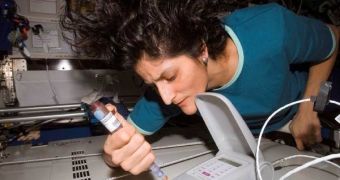Astronauts on the International Space Station now have in their possession a device that would make Start Trek's tricoder look obsolete. The crew members aboard the orbital facility make daily use of a handheld apparatus called the Lab-on-a-Chip Application Development-Portable Test System (LOCAD-PTS), which is able to detect life forms in microgravity, especially if they are of Earth origin. Admittedly, the technology does not supply instant answers, as the result takes a while to be processed.
The purpose of the instrument is to provide a biological analysis of sample swabs, which can be taken from virtually anywhere. After they are harvested, they are placed in a watery solution, which is then inserted in a small reservoir, affixed to the LOCAD-PTS. The results of the chemical analysis appear within 15 minutes on the machine's display, and inform the astronaut who uses it about the contents of the sample, down to chemical levels.
“They like the fact that they can get a result themselves in orbit and not be completely reliant upon the ground or have to send samples back to Earth,” Jake Maule said of the astronauts in orbit. He is a BAE Systems Biologist at the NASA-operated Marshall Space Flight Center, in Alabama, US.
The instrument was first deployed aboard the ISS in December 2006, when it was carried to orbit by the Discovery space shuttle. It was first used on human palms, and then on purified water, to test for its efficiency. As the device performed within established limits, it began to be methodically used to either assess the sanitation level of various objects, or look for random life forms aboard the station.
The LOCAD-PTS was also used during a spacewalk, as astronauts and mission controllers wanted to determine if Earth-based microorganisms could survive in the harsh conditions of space, LiveScience reports. Understanding how bacteria or microbes survive when exposed to radiation and extremely low temperatures could help mission planners devise ways of avoiding cross-contamination between organisms from various planets in the future. The research could be especially important for a manned trip to Mars, where readings run the risk of being distorted by leftover biological samples carried from Earth all the way to the Red Planet.
The life-detecting instrument carries a number of compartments that need to be filled with swab samples, if the results are to be accurate. Each of the openings hosts a different reactant, as in a substance that modifies its properties when it detects a certain other chemical, or group of substances. For example, some enzymes turn green or yellow when they detect chemical leftovers from bacteria or microbes. But the concentrations the device needs to detect are in the picogram (trillionth of a gram) range, which makes research very difficult.

 14 DAY TRIAL //
14 DAY TRIAL //